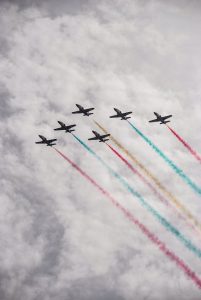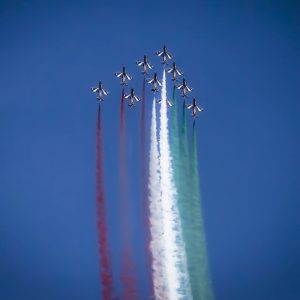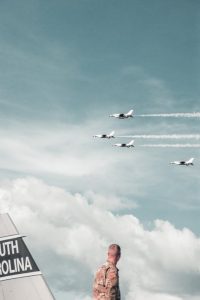Comprehensive Guide To Join The Indian Air Force 2024
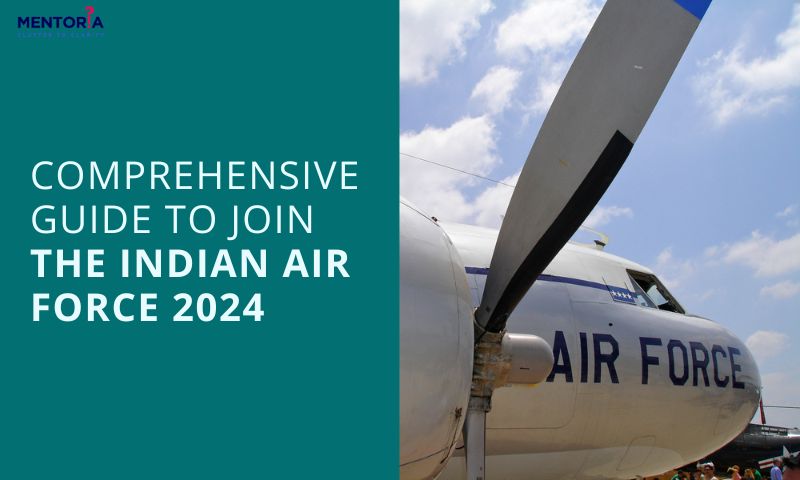
Jump to Section
Not everyone is cut out for spending 8 hours in front of a computer and going home. Some people have a burning desire to serve their country and earn immense respect. These individuals believe in doing something out of the ordinary, and since you’re here, we assume you’re one of them. Many students aspire to join the Indian Army, Indian Air Force, or even the Indian Navy. Are you also interested in joining the Indian Air Force? If so, you’ve come to the right place because this page is dedicated to guiding you through the process of joining the Indian Air Force. Joining the Indian Air Force can be quite confusing. You may be curious about the eligibility criteria, required skills, challenges faced, and the selection process for the exam. In today’s article, we will provide you with all the necessary details. So, let’s get started!
What Is The Indian Air Force?
The Indian Air Force (IAF) is one of the branches of the Indian Armed Forces responsible for aerial warfare and securing Indian airspace. It is the air arm of the Indian military, alongside the Indian Army and the Indian Navy. The IAF primarily conducts air defence operations to protect Indian airspace, aerial reconnaissance, intelligence gathering, and providing air support to ground forces during wartime. The Indian Air Force (IAF) is extremely important in carrying out humanitarian aid and disaster relief missions. Additionally, they are responsible for transporting troops and providing logistical support through their airlift capabilities. The IAF uses a variety of aircraft, including fighter jets, transport planes, and helicopters, to carry out its missions and safeguard the skies of India.
Roles And Responsibilities Of Indian Air Force Personnel
- Air Defense: The main objective of the Indian Air Force (IAF) is to safeguard the Indian airspace against any potential aerial threats. This includes intercepting and neutralising any hostile aircraft that may try to breach Indian borders.
- Aerial Combat: During times of war or conflict, the IAF takes charge of air combat operations. Their mission is to engage enemy aircraft and establish air superiority to support ground operations.
- Airlift and Transport: The IAF possesses the capability to provide airlift services for transporting troops, equipment, and supplies. This enables quick deployment and logistical support for the Indian military and government.
- Aerial Reconnaissance: The IAF conducts aerial reconnaissance missions to gather valuable intelligence on enemy activities, terrain, and other pertinent information. This information aids in military planning and operations.
- Humanitarian Assistance and Disaster Relief (HADR): The IAF plays a vital role in providing assistance during natural disasters, calamities, and emergencies. They achieve this by airlifting relief supplies, evacuating people from affected areas, and offering medical support.
- Training and Development: The IAF ensures that its personnel are well-trained to uphold professionalism and operational readiness. They also invest in research and development to improve their capabilities and stay ahead in aerospace technology.
How To Become An Indian Air Force Officer?
Step 1: Entry Scheme And Eligibility
There are three different ways to join the Indian Air Force: NDA, AFCAT, and NCC.
NDA(National Defence Academy)
If you’re someone who frequently wonders about joining the Indian Air Force through NDA, here’s a simple guide for you:
The UPSC releases the NDA notice twice a year, in June and December.
- Start by applying to the National Defence Academy (NDA).
- Once shortlisted, you’ll embark on a three-year training programme at the NDA.
- After completing the initial training, you’ll undergo specialised training at one of the NDA’s training centres.
- Finally, upon successful completion, you’ll become a Permanent IAF Officer stationed at any of the Air Force Stations.
More Details
- Gender: Men And Women
- Nationality: Indian
- Education: 10+2 with Physics, Chemistry and Mathematics. Final-year students can also apply.
- Branches: Flying Branch. Technical Branch. Non-technical Branch.
- Age Limit: 16 ½ to 19 ½ years(at the time of commencement of course)
Selection Process: The selection process for NDA consists of a written test and an interview conducted by the Service Selection Board (SSB).
- Written Test: Mathematics, General Ability Test. Total Marks: 900
- Interview: psychological test, physical test, personal interview. Total Marks: 900
Marking:
- Correct Answer: 2.5 Marks
- Wrong Answer: -0.83(⅓ of 2.5).
AFCAT(Air Force Common Admission Test)
To become a part of the Indian Air Force, the most popular route is by taking the AFCAT (Air Force Common Admission Test). This exam is available for individuals who have finished their undergraduate or postgraduate studies and have a desire to serve in the Indian Air Force.
Candidates who are interested in joining branches other than NDA must take the AFCAT exam. The AFCAT exam is conducted twice a year, in February and August. The Indian Air Force announces the AFCAT notifications in June and December.
AFCAT also provides entry to the
- Flying branch.
- Ground Duty (Technical) Branch.
- Ground Duty (Non-Technical) Branch.
Here are the details of the AFCAT exam:
Gender: Men and Women
- Education: 60% in maths and physics in 10+2.
Age Limit
- Flying Branch: 20-24 Years
- Ground Duty: 20-26 Years
- Nationality: Indian
- Marital Status: Unmarried
- Subjects: General Awareness. Verbal Ability in English. Numerical Ability. Reasoning and Military Aptitude.
- No. Of Questions: 100
- Max Marks: 300
- Duration: 2 hours
Marking Scheme
- Correct Answer: 3 Marks
- Wrong Answer: (-)1
NCC(National Cadet Corps)
The NCC Air Wing recruits individuals from schools, colleges, and universities. Once selected, they undergo military training in marching and handling small weapons.
If you have an Air Sqn NCC Senior Division ‘C’ certificate, you can apply online through the NCC Special entry.
More Details
- Gender: Men and Women
- Age Limit: 20-24 Years
- Nationality: Indian
- Marital Status: Unmarried
- Notice Month: June and December
- Eligibility: Should have a valid NCC “Air” Wing ‘C’ Certificate.
- Advertisement released by: Indian Air Force/ DISHA Cell.
Step 2: AFSB (Air Force Selection Board) Testing
After acing stage 1, you’ll receive a call letter. To undergo testing, you’ll usually be required to appear at one of the Air Force Selection Boards located in Dehradun, Varanasi, Gandhinagar, or Mysuru. These AFSBs will assess you through a series of tests.
- Stage 1: Psychological Tests. Group Tests. Interview. Computerised Pilot Selection System (CPSS) test (for Flying Branch).
- Stage 2: Psychological Tests. Group Tests. Interview. Computerised Pilot Selection System (CPSS) test (for Flying Branch).
Step 3: Medical Exam
Afterwards, the medical tests will be arranged according to the selection committee. The medical examination will take place either at the Air Force Central Medical Establishment (AFCME) in New Delhi or at the Institute of Aviation Medicine in Bengaluru.
Step 4: All India Merit List
After evaluating your performance in the written exam and AFSB interview, as well as considering your physical and mental health, an All India Merit List is compiled. Based on this list, you will receive joining instructions for the available openings in different branches or sub-branches. You will then be directed to join one of the training facilities.
Perks Of Joining Indian Air Force
Joining the Indian Air Force (IAF) comes with a range of perks and benefits, including:
- Job Security: A career in the IAF provides stable employment with opportunities for advancement based on performance and merit.
- Salary and Allowances: IAF personnel receive competitive salaries along with various allowances such as dearness allowance, flying allowance, and technical allowance.
- Pension and Retirement Benefits: Upon retirement, IAF personnel are entitled to a pension and other retirement benefits as per government regulations.
- Healthcare: Comprehensive medical facilities are provided to IAF personnel and their dependents, including access to military hospitals and medical insurance coverage.
- Housing: Accommodation is provided to IAF personnel, either on base or through housing allowances for off-base living.
- Education: The IAF provides educational opportunities for personnel and their children, including access to schools and colleges run by the Air Force and scholarships for higher education.
- Travel and Leave: IAF personnel enjoy travel concessions and various types of leave, including annual leave, casual leave, and medical leave.
- Recreational Facilities: The IAF provides recreational facilities such as clubs, sports facilities, and other amenities to promote the well-being and morale of its personnel.
- Insurance: IAF personnel are covered by insurance schemes that provide financial security in case of disability or death while in service.
Skills Required To Become An Indian Air Force Officer
To become an Indian Air Force (IAF) officer, you need a combination of skills and qualities that make you a strong candidate for the role.
- Leadership: As an officer, you’ll be responsible for leading a team of airmen and making critical decisions. Good leadership skills, including the ability to inspire and motivate others, are essential.
- Decision-making: Quick and effective decision-making is crucial, especially in high-pressure situations. You should be able to assess situations rapidly and make the best possible decisions.
- Problem-solving: The ability to identify problems, analyse them, and come up with practical solutions is vital. You should be able to think creatively and adapt to changing circumstances.
- Physical Fitness: A high level of physical fitness is required to meet the demands of the job, which can include long hours, strenuous activities, and exposure to challenging environments.
- Communication Skills: Communication skills are crucial for success, whether it’s conveying instructions to your team or collaborating with different military branches and civilian authorities.
- Technical Aptitude: An understanding of aviation and technical aspects related to aircraft operations is beneficial. While you will receive training, having a basic knowledge of these areas can be advantageous.
- Resilience: The ability to cope with setbacks and persevere in the face of challenges is important. Military life can be demanding, and resilience will help you overcome obstacles.
- Teamwork: Collaboration with colleagues and other branches of the military is essential. You should be able to work effectively as part of a team towards common goals.
- Adaptability: The ability to adapt to new situations and environments is crucial, as military operations can vary widely and may require you to adjust quickly.
- Integrity: Being an officer requires you to maintain the utmost integrity and ethics, not only in your professional life but also in your personal life.
Air Force Officer Ranks
The Indian Air Force (IAF) follows a hierarchical structure for its personnel. Here is a list of ranks, starting from the highest to the lowest:
- Marshal of the Indian Air Force: This is an honorary rank awarded as a distinction. It is the highest rank in the IAF, but it is not a substantive rank and is held for life.
- Air Chief Marshal (ACM): This is the highest operational rank in the IAF, responsible for the overall operational effectiveness of the Air Force.
- Air Marshal (AM): This is the second-highest rank in the IAF, and officers at this rank are typically responsible for command of operational air force formations and units.
- Air Vice Marshal (AVM): This is a senior rank in the IAF, and officers at this rank may hold important command or staff appointments.
- Air Commodore (Air Cmde): This is a senior officer rank in the IAF, and officers at this rank may command air force bases or hold senior staff appointments.
- Group Captain (Gp Capt): This is a middle-ranking officer rank in the IAF, and officers at this rank may command squadrons or serve in staff appointments.
- Wing Commander (Wg Cdr): This is a senior flight officer rank in the IAF, and officers at this rank may command wings or serve in other senior positions.
- Squadron Leader (Sqn Ldr): This is a junior officer rank in the IAF, and officers at this rank typically command flights or serve in other junior leadership positions.
- Flight Lieutenant (Flt Lt): This is a mid-ranking officer rank in the IAF, and officers at this rank serve as pilots or in other junior officer roles.
- Flying Officer (Fg Offr): This is the lowest commissioned officer rank in the IAF, and officers at this rank are typically in the early stages of their careers.
In addition to commissioned officers, the IAF also has non-commissioned officers (NCOs) and airmen who serve in various technical, administrative, and support roles.
Top Branches Of Indian Air Force
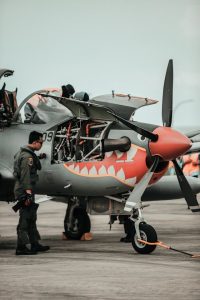
The Indian Air Force (IAF) is made up of various branches, each with its own specific role. Let’s take a look at some of the main branches:
- Flying Branch: This branch is all about air operations. It includes skilled pilots and flying crew who handle different aircraft in the IAF’s fleet.
- Technical Branch: The Technical Branch takes care of aircraft maintenance and ensures that all technical aspects of the aircraft systems and equipment are managed effectively.
- Ground Duty Branch: The Ground Duty Branch plays a crucial role in the IAF’s functioning. It covers administrative, logistical, and support roles like administration, logistics, accounts, education, and meteorology.
- Meteorological Branch: The Meteorological Branch is responsible for providing weather forecasts and meteorological support to IAF operations. They make sure that flying conditions are safe and optimal.
- Education Branch: The Education Branch focuses on providing education and training to IAF personnel. They cater to the needs of pilots, technical staff, and other personnel.
- Accounts Branch: The Accounts Branch handles the financial aspects of the IAF. They take care of budgeting, accounting, and financial planning.
- Logistics Branch: The Logistics Branch manages the supply chain and logistics of the IAF. They ensure that all personnel have the necessary equipment and supplies to carry out their duties effectively.
All these branches work together harmoniously to ensure the smooth functioning of the Indian Air Force and its ability to carry out its mission successfully.
Salary Of Indian Air Force Personnel
- Air Chief Marshal: INR 2,50,000 per month
- Air Marshal Apex Scale: INR 2,05,400 per month
- Air Marshal HAG Scale: INR 1,82,200 per month
- Air Vice Marshal: INR 1,44,200 per month
- Air Commodore: INR 1,34,400 per month
- Group Captain: INR 1,25,700 per month
- Wing Commander: INR 1,16,700 per month
- Squadron Leader: INR 69,400 per month
- Flight Lieutenant: INR 61,300 per month
- Flying Officer: INR 56,100 per month
Challenges Faced By Air Force Personnel
Air Force personnel encounter a range of obstacles, such as:
- Operational Challenges: These involve the dangers associated with flying aircraft, like mechanical issues, weather conditions, and combat scenarios.
- Physical and Mental Strain: The demanding nature of Air Force operations can result in physical exhaustion and mental stress, particularly during lengthy deployments or combat missions.
- Separation from Family: Military personnel often have to endure extended periods away from their loved ones, which can be emotionally difficult.
- Transitioning to Civilian Life: Adjusting from military to civilian life can be challenging for some Air Force personnel, especially when it comes to finding employment and adapting to a different lifestyle.
- Job Security: While the Air Force offers stable employment, uncertainties regarding postings, promotions, and future career prospects may arise.
- Operating Environment: The Air Force operates in diverse environments, including extreme weather conditions, high altitudes, and challenging terrains, which can present physical and logistical challenges.
- Keeping up with Technology: Staying abreast of rapidly evolving technology and equipment necessitates continuous training and adaptation, which can be demanding.
- Personal Sacrifices: Air Force personnel often have to make personal sacrifices, such as missing important family events and holidays, in service to their country.
- Risk of Injury or Death: The nature of Air Force operations carries inherent risks, including the possibility of injury or death while on duty.
- Maintaining Work-Life Balance: Balancing the demands of military service with personal and family life can be challenging, particularly during deployments and extended missions. Check out our webinars that delve into the Indian Air Force. By watching them, you’ll gain a better understanding of their operations and get a clearer insight into what they do.
A Dream Worth Pursuing
We’ve got all the information you need to know about joining the AirForce. It’s definitely something to be proud of, serving your country. Joining the Air Force will set you up for a strong career, where you can grow both personally and professionally. Plus, you’ll have the opportunity to take part in exciting adventure activities like scuba diving, paragliding, skydiving, and more. If you need any further assistance, feel free to reach out to us. We’ll do our best to provide you with the guidance you need. Discover your potential with Mentoria’s student guidance. Whether you want to excel in your studies, explore new academic paths, or switch to a different field, our mentors will create a personalised plan just for you. With a wide range of streams, over 850 courses, and insights into 12,000+ careers, we’re here to help you find your perfect academic fit. Connect with our counsellors today and start your journey towards a fulfilling and successful student life.
